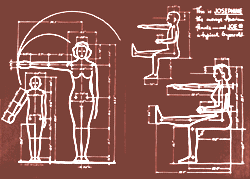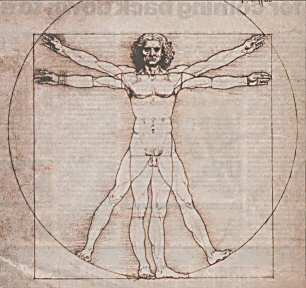 Henry
Dreyfuss
Henry
DreyfussSimon & Schuster, 1955
Reprinted in Viking, 1974
ISBN 0670003921
 Henry
Dreyfuss
Henry
Dreyfuss
Simon & Schuster, 1955
Reprinted in Viking, 1974
ISBN 0670003921
Buy it from Amazon.com
Buy it from Amazon.co.uk
Einkaufen von Amazon.de
Other Reviews

"To me, Leonardo da Vinci is a symbol; artist, scientist, engineer, rebel -- and the greatest of all ndustrial designers -- he boldly put his dreams on paper. I find it fascinating to speculate about what Leonardo's thoughts would be if he were alive today." (page 19)
Dreyfuss' industrial autobiography (could anyone write such a thing today?) is not just a classic but a beautiful book in every sense. The echoes between Dreyfuss, with his Joe and Josephine figures (see illustration above) and Leonardo da Vinci's Man inscribed heroically in a circle are perhaps a little too self-conscious, but Dreyfuss really was a bit of a Renaissance Man, at once artist, designer, founder of the discipline of Human Factors, author, publicist, and businessman.
Time is visible in many ways in this book, not least in its physical format: a good-sized cloth-bound hardback, with an elegant typography on slightly yellowing paper, printed in two colours -- black and a warm reddish-brown for the illustrations and headings. The language and cultural preconceptions, too, bespeak an earlier and more gracious age. For Dreyfuss may have been an American, but he was well-travelled and loved France (among other things). When he writes
'Frequently I hear people say, with or without intended snobbery, that Americans are so engrossed in materialistic values that culture is lost on them.' (page 82)
he is plainly speaking in defence not just of his fellow-citizens but of himself. And of course he goes on to point out the merits of 'well-designed, mass-produced goods', even claiming them to constitute a new art form. His Hoover vacuum cleaner was the first to be designed to do what housewives needed - to go under furniture, to be light to carry, to stow the cable neatly, and it still looks serviceable today.

As Sven Birkerts writes, just the look of an old book gives us a reminder of the length of history, and the time people have thought about design:
"Say what you like about books, they not only mark the backward trail, but they also encode this sense of ostacle, of otherness. The look of the printed page changes as we regress in time; under the orthographic changes are the changes in the language itself. Old-style textual research may feel like an unnecessarily slow burrowing, but it is itself an instruction" (Birkerts, page 137)
There are plenty of reminders of time in Dreyfuss' book. Not least are the reminders of just how recent are the gadgets we take for granted: "Today the convenience of telephones is established". Requirements engineering was in those days called design, or at least in no way differentiated from it, but design was seen mainly as what happened on the surface, with 'engineering' going on underneath:
"I suggested that a telephone's appearance should be developed from the inside out, not merely created as a mold into which the engineers would eventually squeeze the mechanism, and this would require collaboration with Bell technicians. My visitor disagreed, saying such collaboration would only limit a designer's artistic scope.Several months later he returned..." (Dreyfuss, pages 102-3)
Dreyfuss exudes the confidence of a Benvenuto Cellini (an Italian renaissance silversmith who wrote a not very modest autobiography) -- he was evidently delighted with his own work, in a way which is engagingly simple and direct, but which would scarcely be acceptable today.
Yet he pioneered all manner of practices that we take for granted.
"The cost of a model is more than compensated for by future savings. It not only presents an accurate picture of the product for the executives, but it also gives the toolmakers and production men an opportunity to criticize and to present manufacturing problems. Models of some products can be made for a few hundred dollars. ... A mock-up of a modern passenger airplane cabin may cost $150,000 but it will be worth it, for it permits engineers and designers to develop techniques of installation that would not otherwise be possible. Furthermore, sales executives can bring potential customers into a faithful, full-scale fuselage to see what it offers, long before production begins. It is far more effective to sit in a chair than judge its comfort by a picture of it." (page 62)
How many kinds of critical stakeholder did you notice being integrally involved in the multi-functional team's participative development life-cycle approach there? Dreyfuss writes without the grating management-speak jargon we see every day, but he understood exactly why it helped to consider what people needed, and how to ensure they understood what they would get. His emphasis on manufacturability -- as we now call it -- is also startlingly modern. There's even a chapter called 'The Importance of Testing'.
Dreyfuss is widely acknowledged to be a founder of modern industrial design and of human factors. On the evidence of this book, he might also be seen as a pioneer in participative design, in attention to stakeholder viewpoints from usability to production, and in the importance of continuity between specification and testing. He's also such fun to read that the search for an old hardcover edition is well worth while.
© Ian Alexander 2003
See also: Exhibit on Dreyfuss at the Cooper-Hewitt National Design Museum Smithsonian Institution You may also like: